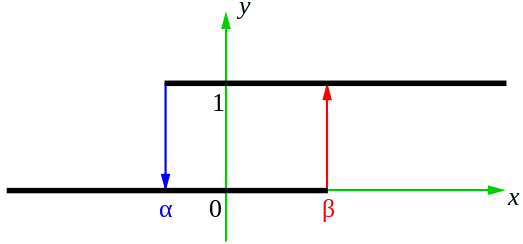Preisach model of hysteresis
Originally, the Preisach model of hysteresis generalized magnetic hysteresis as relationship between magnetic field and magnetization of a magnetic material as the parallel connection of independent relay hysterons. It was first suggested in 1935 by Ferenc (Franz) Preisach in the German academic journal "Zeitschrift für Physik".[1] In the field of ferromagnetism, the Preisach model is sometimes thought to describe a ferromagnetic material as a network of small independently acting domains, each magnetized to a value of either or . A sample of iron, for example, may have evenly distributed magnetic domains, resulting in a net magnetic moment of zero. Mathematically similar model seems to have been independently developed in other fields of science and engineering. One notable example is the model of capillary hysteresis in porous materials developed by Everett and co-workers. Since then, following the work of people like M. Krasnoselkii, A. Pokrovskii, A. Visintin, and I.D. Mayergoyz, the model has become widely accepted as a general mathematical tool for the description of hysteresis phenomena of different kinds.[2][3]
Nonideal relay
The relay hysteron is the fundamental building block of the Preisach model. It is described as a two-valued operator denoted by . Its I/O map takes the form of a loop, as shown:

Above, a relay of magnitude 1. defines the "switch-off" threshold, and defines the "switch-on" threshold.
Graphically, if is less than , the output is "low" or "off." As we increase , the output remains low until reaches —at which point the output switches "on." Further increasing has no change. Decreasing , does not go low until reaches again. It is apparent that the relay operator takes the path of a loop, and its next state depends on its past state.
Mathematically, the output of is expressed as:
Where if the last time was outside of the boundaries , it was in the region of ; and if the last time was outside of the boundaries , it was in the region of .
This definition of the hysteron shows that the current value of the complete hysteresis loop depends upon the history of the input variable .
Discrete Preisach model
The Preisach model consists of many relay hysterons connected in parallel, given weights, and summed. This is best visualized by a block diagram:
Each of these relays has different and thresholds and is scaled by . Each relay can be plotted on a so-called Preisach plane with its values. Depending on their distribution on the Preisach plane, the relay hysterons can represent hysteresis with good accuracy. As well, with increasing , the true hysteresis curve is approximated better.
In the limit as approaches infinity, we obtain the continuous Preisach model.
The plane
One of the easiest ways to look at the Preisach model is using a geometric interpretation. Consider a plane of coordinates . On this plane, each point is mapped to a specific relay hysteron .
We consider only the half-plane as any other case does not have a physical equivalent in nature.
Next, we take a specific point on the half plane and build a right triangle by drawing two lines parallel to the axes, both from the point to the line .
We now present the Preisach density function, denoted . This function describes the amount of relay hysterons of each distinct values of . As a default we say that outside the right triangle .
A modified formulation of the classical Preisach model has been presented, allowing analytical expression of the Everett function.[4] This makes the model considerably faster and especially adequate for inclusion in electromagnetic field computation or electric circuit analysis codes.
Vector Preisach Model
The vector Preisach model is constructed as the linear superposition of scalar models.[5] For considering the uniaxial anisotropy of the material, Everett functions are expanded by Fourier coefficients. In this case, the measured and simulated curves are in a very good agreement.[6] Another approach uses different relay hysteron, closed surfaces defined on the 3D input space. In general spherical hysteron is used for vector hystersis in 3D,[7] and circular hysteron is used for vector hystersis in 2D.[8]
References
- Preisach, F (1935). "Über die magnetische Nachwirkung". Zeitschrift für Physik. 94: 277–302. Bibcode:1935ZPhy...94..277P. doi:10.1007/bf01349418.
- Smith, Ralph C. (2005). Smart material systems : model development. Philadelphia, Pa.: SIAM, Society for Industrial and Applied Mathematics. p. 189. ISBN 978-0-89871-583-5.
- Visintin, Augusto (1994). Differential models of hysteresis. Berlin, Heidelberg: Springer Berlin Heidelberg. ISBN 978-3-662-11557-2.
- Szabó, Zsolt (February 2006). "Preisach functions leading to closed form permeability". Physica B: Condensed Matter. 372 (1–2): 61–67. Bibcode:2006PhyB..372...61S. doi:10.1016/j.physb.2005.10.020.
- Mayergoyz, I.D. (2003). Mathematical models of hysteresis and their applications (1st ed.). Amsterdam: Elsevier. ISBN 978-0-12-480873-7.
- Kuczmann, Miklos; Stoleriu, Laurentiu. "Anisotropic vector Preisach model" (pdf). Journal of Advanced Research in Physics. 1 (1): 011009. Retrieved 3 August 2016.
- Cardelli, Ermanno; Della Torre, Edward; Faba, Antonio (2010). "A General Vector Hysteresis Operator: Extension to the 3-D Case". IEEE Transactions on Magnetics. 46 (12): 3990–4000. doi:10.1109/tmag.2010.2072933.
- Cardelli, Ermanno (2011). "A general hysteresis operator for the modeling of vector fields". IEEE Transactions on Magnetics. 47 (8): 2056–2067. doi:10.1109/tmag.2011.2126589.
External links
- University College, Cork Hysteresis Tutorial
- Budapest University of Technology and Economics, Hungary Matlab implementation of the Preisch model developed by Zs. Szabó.